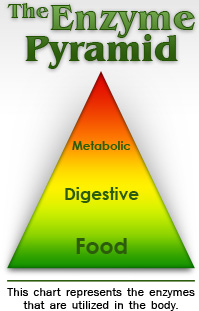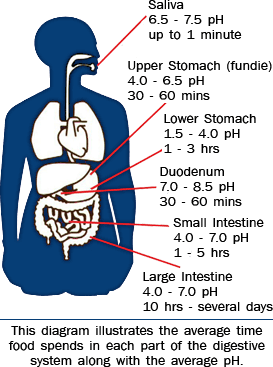Additional Info
 With the basic understanding of enzymes and digestion let’s look at what happens to your body over the period of one life-time. Your body was specifically designed to function on raw, enzyme-rich foods which support the digestive and metabolic enzymes found naturally in the body (see Enzyme Pyramid Chart on the left side). When enzymes are present in the raw foods you eat they “predigest” themselves and are readily assimilated. Think of what happens when you eat a salad for lunch. How long does it take before you’re hungry again? Now, let’s look at what happens when you lower your body’s enzyme level through eating enzyme-deficient foods. Enzymes occurring naturally in foods are destroyed by heating, cooking, pasteurizing or processing. At the bottom of the Enzyme Pyramid are the food enzymes received from the foods you eat. They are the most abundant and are the foundation of our health and longevity. When these food enzymes are not replenished on a daily basis, your body is forced to supply all of the enzymes needed to digest that cooked food. This is where the The Law of Adaptive Secretion that was established in 1943 is important. This law holds that an organism values its enzymes highly and will make no more than are needed for the job. These enzymes come from your digestive system or the second level of the Enzyme Pyramid. After years or decades of eating patterns that lack enzymes, your body will eventually use up its own digestive enzymes or the building blocks needed to make them. What may show up at this point are a host of side effects that include acid reflux, gas, belching, heartburn, indigestion, nausea and upset stomach. These symptoms are not a result of too much HCI and enzymes but way too few. Your body has now used up the two lower levels of the Enzyme Pyramid.
With the basic understanding of enzymes and digestion let’s look at what happens to your body over the period of one life-time. Your body was specifically designed to function on raw, enzyme-rich foods which support the digestive and metabolic enzymes found naturally in the body (see Enzyme Pyramid Chart on the left side). When enzymes are present in the raw foods you eat they “predigest” themselves and are readily assimilated. Think of what happens when you eat a salad for lunch. How long does it take before you’re hungry again? Now, let’s look at what happens when you lower your body’s enzyme level through eating enzyme-deficient foods. Enzymes occurring naturally in foods are destroyed by heating, cooking, pasteurizing or processing. At the bottom of the Enzyme Pyramid are the food enzymes received from the foods you eat. They are the most abundant and are the foundation of our health and longevity. When these food enzymes are not replenished on a daily basis, your body is forced to supply all of the enzymes needed to digest that cooked food. This is where the The Law of Adaptive Secretion that was established in 1943 is important. This law holds that an organism values its enzymes highly and will make no more than are needed for the job. These enzymes come from your digestive system or the second level of the Enzyme Pyramid. After years or decades of eating patterns that lack enzymes, your body will eventually use up its own digestive enzymes or the building blocks needed to make them. What may show up at this point are a host of side effects that include acid reflux, gas, belching, heartburn, indigestion, nausea and upset stomach. These symptoms are not a result of too much HCI and enzymes but way too few. Your body has now used up the two lower levels of the Enzyme Pyramid.
“Life could not be defined as an orderly, integrated succession of enzymatic reactions”
 Enzymes are the single most important element of your health and far outweigh the importance of any other nutrient. Nothing in the human body functions without enzymes making it happen. Without exception, every new “breakthrough” nutritional product being introduced on the market depends entirely upon enzymes (i.e. MSM, HGH, 5HDP, DHEA, Vitamins, Minerals, Amino Acids, etc.) for its effectiveness. So, what are enzymes? Enzymes are:
Enzymes are the single most important element of your health and far outweigh the importance of any other nutrient. Nothing in the human body functions without enzymes making it happen. Without exception, every new “breakthrough” nutritional product being introduced on the market depends entirely upon enzymes (i.e. MSM, HGH, 5HDP, DHEA, Vitamins, Minerals, Amino Acids, etc.) for its effectiveness. So, what are enzymes? Enzymes are:
- Proteins that hold an electrical charge
- Catalysts that speed up chemical processed without being used up in the process
- Specific in that they only cut certain bonds that hold proteins, sugars or fats together
- Effective in that one enzyme can bread-down millions of bonds
Where do enzymes come from?
 Enzymes come from one of three sources; plants, animals, or microbes (see Enzyme Comparison Chart). Plant enzymes (bromelain and papain) work in a wide pH range but only digest some proteins. Animal enzymes (pepsin, pancreatin) work in a very limited pH range and only digest some of the food groups. The microbial enzymes (Digestive Enzyme HP270V) are the only ones that work in a wide pH range and will digest all of the food groups. Acid and alkaline are the two words most commonly associated with pH. pH means hydrogen potential or the number of hydrogen ions in a solution (see pH Range Chart). More hydrogen = acidic Less hydrogen = alkaline
Enzymes come from one of three sources; plants, animals, or microbes (see Enzyme Comparison Chart). Plant enzymes (bromelain and papain) work in a wide pH range but only digest some proteins. Animal enzymes (pepsin, pancreatin) work in a very limited pH range and only digest some of the food groups. The microbial enzymes (Digestive Enzyme HP270V) are the only ones that work in a wide pH range and will digest all of the food groups. Acid and alkaline are the two words most commonly associated with pH. pH means hydrogen potential or the number of hydrogen ions in a solution (see pH Range Chart). More hydrogen = acidic Less hydrogen = alkaline
The pH in the human digestive tract varies greatly (see Human Digestive Tract pH Range Chart). The pH of saliva is usually between 6.5 – 7.5. After we chew and swallow food it then enters the fundic or upper portion of the stomach which has a pH between 4.0 – 6.5. This is where “predigestion” occurs while the lower portion of the stomach is secreting hydrochloric acid (HCI) and pepsin until it reaches a pH between 1.5 – 4.0. After the food mixes with these juices it then enters the duodenum (small intestine) where the pH changes to 7.0 – 8.5. This is where 90% of the absorption of nutrients is taken in by the body while the waste products are passed out through the colon (pH 4.0 – 7.0).
With the basic understanding of enzymes and digestion let’s look at what happens to your body over the period of one life-time. Your body was specifically designed to function on raw, enzyme-rich foods which support the digestive and metabolic enzymes found naturally in the body (see Enzyme Pyramid Chart). When enzymes are present in the raw foods you eat they “predigest” themselves and are readily assimilated. Think of what happens when you eat a salad for lunch. How long does it take before you’re hungry again? Now, let’s look at what happens when you lower your body’s enzyme level through eating enzyme-deficient foods. Enzymes occurring naturally in foods are destroyed by heating, cooking, pasteurizing or processing. At the bottom of the Enzyme Pyramid are the food enzymes received from the foods you eat. They are the most abundant and are the foundation of our health and longevity. When these food enzymes are not replenished on a daily basis, your body is forced to supply all of the enzymes needed to digest that cooked food. This is where “The Law of Adaptive Secretion” that was established in 1943 is important. This law holds that an organism values its enzymes highly and will make no more than are needed for the job. These enzymes come from your digestive system or the second level of the Enzyme Pyramid. After years or decades of eating patterns that lack enzymes, your body will eventually use up its own digestive enzymes or the building blocks needed to make them. What may show up at this point are a host of side effects that include acid reflux, gas, belching, heartburn, indigestion, nausea and upset stomach. These symptoms are not a result of too much HCI and enzymes but way too few. Your body has now used up the two lower levels of the Enzyme Pyramid.
Do you stop eating now?
 No, you continue to eat enzyme-deficient foods that will now begin to rob the enzymes that perform all of your internal bodily functions. They are referred to as metabolic enzymes or the third level of the Enzyme Pyramid. Once this process starts, whatever genetic weaknesses or tendencies that run in your family-tree may begin to appear (i.e. cancer, diabetes, heart disease). Because of the limited number of metabolic enzymes and the importance of their functions, the body will deteriorate at a very rapid pace. Death occurs when your final enzyme has been used up. !When digestive enzymes are taken with meals there are a number of benefits:
No, you continue to eat enzyme-deficient foods that will now begin to rob the enzymes that perform all of your internal bodily functions. They are referred to as metabolic enzymes or the third level of the Enzyme Pyramid. Once this process starts, whatever genetic weaknesses or tendencies that run in your family-tree may begin to appear (i.e. cancer, diabetes, heart disease). Because of the limited number of metabolic enzymes and the importance of their functions, the body will deteriorate at a very rapid pace. Death occurs when your final enzyme has been used up. !When digestive enzymes are taken with meals there are a number of benefits:
- Gas, Bloating, Indigestion and Heartburn
- Better Elimination
- Constipation
- Weight Loss
- Increased Energy Levels
- Blood Sugar Levels
- Hiatal Hernias and Ulcers
- Lactose Tolerance
 Enzymes and fiber are essential for proper digestion and elimination. Sadly, the typical American diet is generally significantly lacking in these requirements. Fiber acts as a bulking agent and speeds transit time of food in the digestive tract. These actions prevent metabolic waste from creating toxic by-products. A major benefit of fiber is that it binds acids to bile and carries the bile along with excess fats out of the body. Fiber helps to lower cholesterol, reduce the risk of heart disease, lower blood pressure, improve blood sugar, and promote the growth of friendly intestinal flora. It also promotes bowel regularity, aids digestion, and helps to keep the bowel clean.
Enzymes and fiber are essential for proper digestion and elimination. Sadly, the typical American diet is generally significantly lacking in these requirements. Fiber acts as a bulking agent and speeds transit time of food in the digestive tract. These actions prevent metabolic waste from creating toxic by-products. A major benefit of fiber is that it binds acids to bile and carries the bile along with excess fats out of the body. Fiber helps to lower cholesterol, reduce the risk of heart disease, lower blood pressure, improve blood sugar, and promote the growth of friendly intestinal flora. It also promotes bowel regularity, aids digestion, and helps to keep the bowel clean.
Fiber cannot do its job effectively unless enzymes do theirs. Over time, hard-to-digested high-protein foods (such as cooked meat and other enzyme-deficient foods) exhaust the digestive organs until they can no longer function efficiently. This results in the accumulation of partially digested food in the bowel. By middle age many people have as much as 20 pounds of undigested, putrefactive food in their colon. Toxins produced from this putrefactive buildup are reabsorbed into the bloodstream, creating autointoxication, or self -poisoning. This results in a dramatically weakened immune system and can lead to serious debilitating health problems including colon cancer.
 One of the primary keys to weight loss may simply be the action of enzymes. Dr. David Galton at Tufts University School of Medicine tested people weighing 230-240 pounds. He found that virtually all of them were lacking lipase enzymes in their fatty tissues. Lipase, found abundantly in raw foods, is a fat-splitting enzyme that aids the body in digestion, the storage and distribution of fat, and the burning of fat for energy. Lipase activity breaks down and dissolves fat throughout the body. Without lipase, fat stagnates and accumulates in the organs, arteries, and capillaries. You will see it on hips, thighs, buttocks and stomach, etc.
One of the primary keys to weight loss may simply be the action of enzymes. Dr. David Galton at Tufts University School of Medicine tested people weighing 230-240 pounds. He found that virtually all of them were lacking lipase enzymes in their fatty tissues. Lipase, found abundantly in raw foods, is a fat-splitting enzyme that aids the body in digestion, the storage and distribution of fat, and the burning of fat for energy. Lipase activity breaks down and dissolves fat throughout the body. Without lipase, fat stagnates and accumulates in the organs, arteries, and capillaries. You will see it on hips, thighs, buttocks and stomach, etc.
A good example of the importance of lipase activity lies in an interesting experiment with pigs. Veterinarians fed one group of pigss only enzyme-rich raw potatoes and another group enzyme deficient cooked potatoes. The pigs eating the raw potatoes did not get fat. However, the pigs eating cooked potatoes gained weight rapidly. The regular use of digestive food enzymes that include lipase with meals often results in shedding excess pounds.
 What about sugar? Unprocessed raw sugar contains enzymes, chromium, and B vitamins and is easily digested and assimilated. White processed sugar contains no enzymes, no B vitamins, and no chromium. In order for the body to metabolize processed sugar, the missing vitamins and chromium must be stolen from the body’s own tissue stores. If large quantities of white sugar are eaten, then not only are the body’s enzymes depleted, but we suffer B vitamin and chromium deficiencies. Chromium is an essential mineral needed by the body to support efficient insulin function. Insulin regulates the metabolism of proteins, carbohydrates, and fats. Studies show a relationship between obesity and chromium deficiencies. B vitamins are considered coenzymes essential to the metabolism of all cells.
What about sugar? Unprocessed raw sugar contains enzymes, chromium, and B vitamins and is easily digested and assimilated. White processed sugar contains no enzymes, no B vitamins, and no chromium. In order for the body to metabolize processed sugar, the missing vitamins and chromium must be stolen from the body’s own tissue stores. If large quantities of white sugar are eaten, then not only are the body’s enzymes depleted, but we suffer B vitamin and chromium deficiencies. Chromium is an essential mineral needed by the body to support efficient insulin function. Insulin regulates the metabolism of proteins, carbohydrates, and fats. Studies show a relationship between obesity and chromium deficiencies. B vitamins are considered coenzymes essential to the metabolism of all cells.
Candidiasis adversely affects the endocrine system and nervous system and has a devastating effect on the immune system. Candidiasis is an overgrowth of common yeast that lives in the intestinal track. Yeast overgrowth is triggered by the killing off of friendly bacteria in the intestinal tract, which generally keeps it under control. It is estimated that at least 50% of the population may be affected by this condition.
Candidiasis and allergies affect millions of people. Cause and prevention of both conditions are similar. Allergens and antigens such as viruses, bacteria, fungi, and yeast are most often proteins. They enter the body via the digestive tract. Allergens may also be breathed into the body via the lungs. Protease is a digestive enzyme needed in tremendous quantities to digest and eliminate these toxic invaders, not only in the digestive tract but in the bloodstream as well. Most antigens, including yeast, can be eliminated by taking supplemental enzymes with meals and between meals. It is also advisable to take supplements that will help to reestablish friendly intestinal flora.

